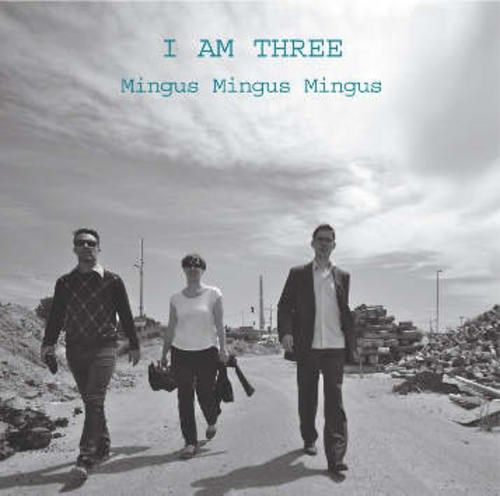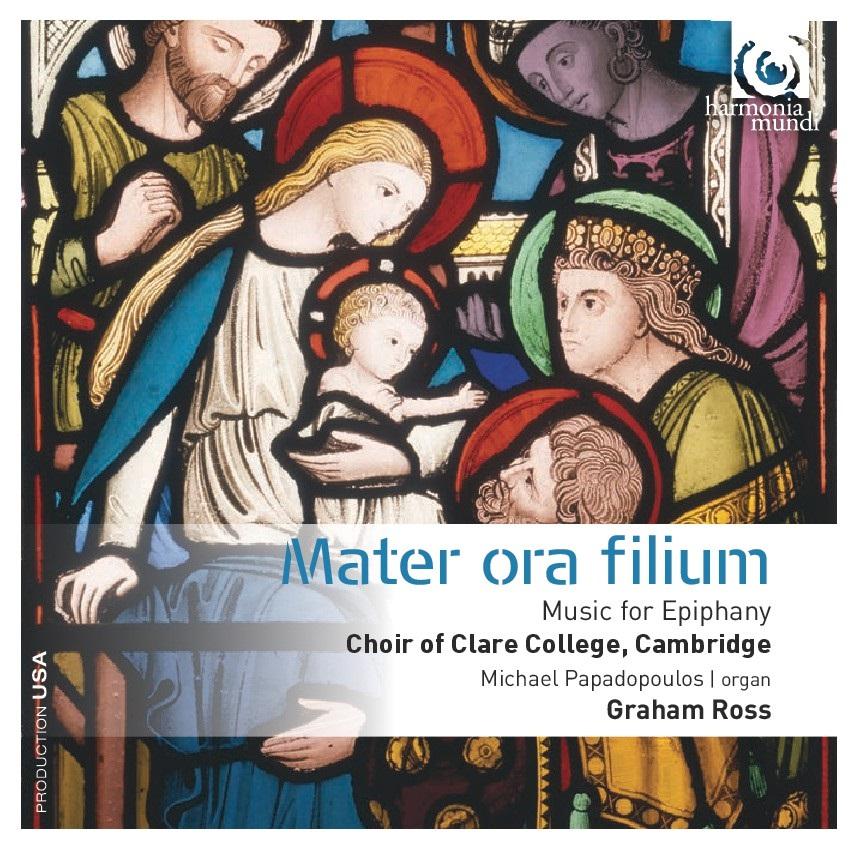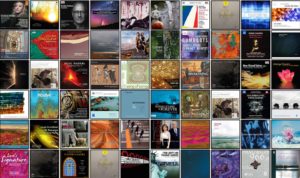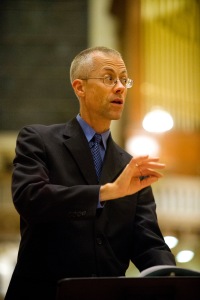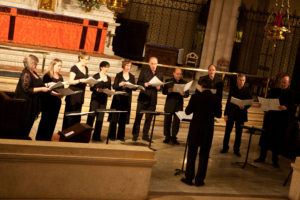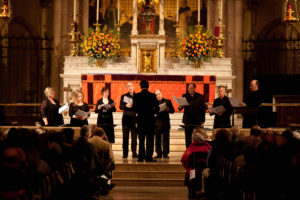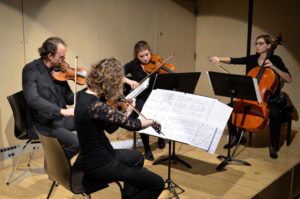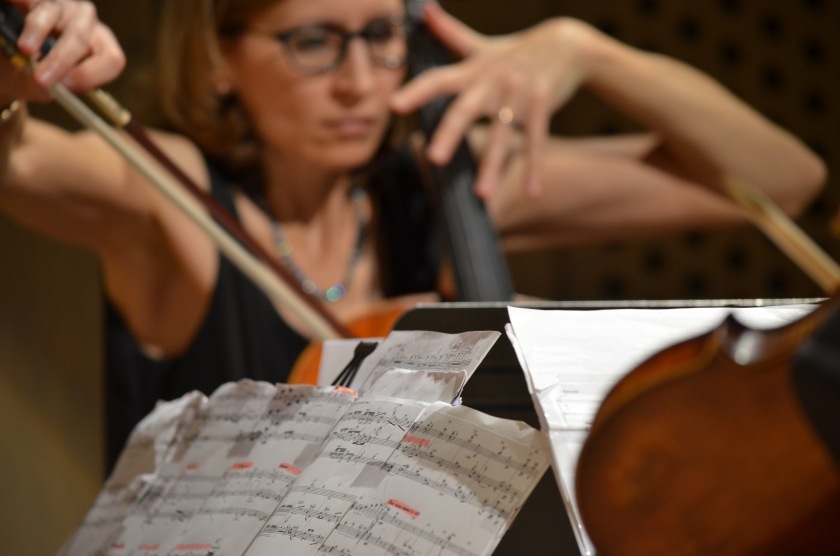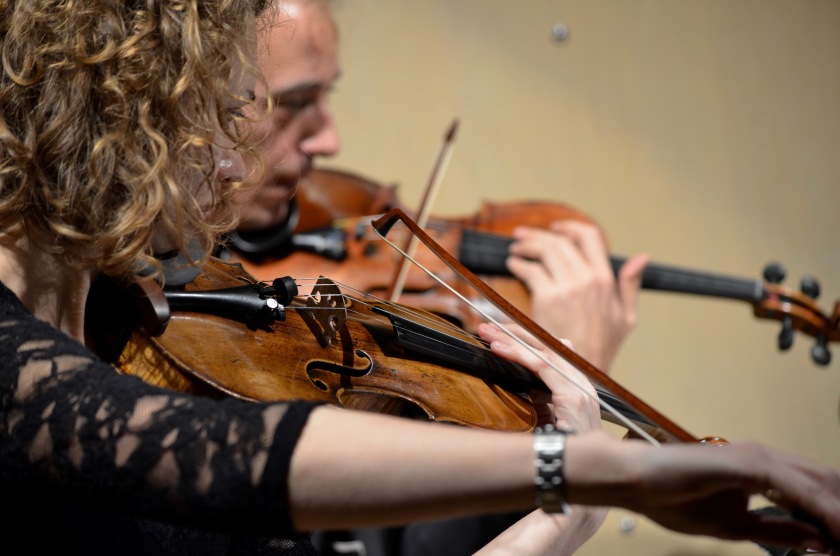

- What attracts you to composing for and performing on the toy piano?
The sound of the toy piano evokes an idealized childhood, the sort that no one I know actually enjoyed and yet many of us possess as a shared mental experience. I love having that association underlying my explorations of disturbing and unusual sounds. In addition, it’s relatively easy to travel with one—certainly compared to a cello—and I like that there’s a basic keyboard interface alongside all sorts of other ways to interact with the instrument. When I first started playing live, it was also a huge selling point to me that there isn’t a standard performance practice with the toy piano, so I could do what felt comfortable to me without feeling like there was going to be someone in the audience shaking their head at the way that I hold my hands or where I place my feet. I keep thinking that I’ll move on to other instruments, and have plans to build some original ones, but then I keep finding other things that I can make this little box do.
- Did the macabre image of the title provide a jumping off point for the winds piece or was it incorporated latter on?
When I first discovered that the Nutshell Studies existed, before I even saw them in person, I knew that I would have to eventually use them as the title for a major toy piano piece. They are a remarkably close analogy to what I do with the toy piano in that they take something associated with childhood (dollhouses in this case) and treat them in a very adult manner. And even though they portray an extreme fascination with death, they are actual tools that are used to assist people studying forensic science, and so are not sensationalist or exploitative. So the title sets up the exact expectations that I want for the piece.

- What microtonal tunings do you use in the wind ensemble piece? How did you manage to detune the banjo? What other tunings appear in your music?
Like you, I do enjoy lots of different temperaments! Since every toy piano is tuned differently from each other, and none of them are in anything close to equal temperament, I tried to place the toy piano within an environment where its unique scale wouldn’t sound too wrong. From the very first conceptualizations of the piece, I knew that I needed an instrument to link the toy piano to the ensemble, in this case, the banjo. Two strings of the five-string banjo are one quarter-tone sharp of their regular tuning, and in writing the part I was very specific as to which notes were played on which strings. And so we I created a continuum from the aleatoric tuning of the toy instrument, through the professional instrument with folk associations tuned in order to make it sound somewhat distorted, into the more standard concert instruments. In that piece, concert instruments use quarter tones as well. Some Details of Hell also uses a lot of quarter tones, in that case in order to explore resonance off of a single low pitch. In A Baby Bigger Than Up Was, I compose out the vowel formants from the repeated text, which required a more systematic approach to mictrotones, using naturally-tuned thirds and sevenths in addition to quarter tones.
- Your text-setting often takes a deconstructionist or fragmentary approach. Tell us a little about how you view writing for the voice and texted scores in general.
I love words and writing! I love them so much that sometimes I can feel hamstrung when I try to set a text. And I think that the human voice remains the absolutely most beautiful and expressive instrument that we have yet created. So, for several years I avoided text entirely while writing for voice. Some Details of Hell is the last piece in which I took a published poem that I love and tried to set it as clearly as possible. In that case, I spent months analyzing the poem, including its line breaks, and figuring out exactly how I could do justice to Brock-Broido’s incredible sensitivity to language. A Baby Bigger Grows Than Up Was is my most recent work for voice, and marks my return to the idea of text setting. But the text for that piece is unique in that it’s a story with all of the hallmarks of a narrative but published in alphabetical order, beginning with 19 iterations of the word “a” and ending with nearly an entire page of punctuation. So, every word is set exactly as it was published, but the text itself is organized in a non-narrative manner. The excerpt on the CD brings us from “a” to “breathing” in five minutes, but the entire piece is nearly an hour long—it all gets pretty intense when we reach the ms and the 72 statements of the word “mom” and 442 of the word “my”!
- The idea of looping appears in two different guises on the album: down.stream where you use a loop pedal on your toy piano and the overdubbed bassoons on 21 Miles to Coolville (bonus points for that title, by the way). Obviously, your music eschews a conventional approach to minimalism. But irregular sorts of repetitions prove to be a throughline, from your vocal settings to the aforementioned looping structures. How do you deal with repetition in your compositional language?
We never experience true repetition. Each time an event is encountered, we perceive it within a context, and any previous contact with that idea or similar ones colors the new experience. I’m fascinated by that idea and also by nature, where near repetition is quite common, but true repetition is almost unimaginable. I think a great deal about listening to the interaction between various bird calls, or predicting ocean waves, or watching rivers where the water is forever changing and forever the same. A friend recently sent me an India Times take on how repetition in digital content supposedly dulls creativity—but I’ve never quite agreed with that view. For me, repetition—especially nuanced, evolving repetition—is a source of fascination, not fatigue. In my music, I try to play with these concepts by having ideas or words or motives recur but generally subtly changed. 21 Miles to Coolville (and thanks!) is completely written out, and has been played by four bassoons and also by Michael Parker Harley as a solo with prerecorded Harleys. The only difference in how I created that piece from any previous compositions is that the quarter note pulse remains constant throughout. And my approach to looping pedal in my solo performances is a bit different from most people in that I generally am using it to create drones and sustained sounds, which are otherwise incredibly difficult to produce on the toy piano, and to allow for the buildup of more orchestral textures. When I was in high school, the music of the minimalist composers was one of my first entries into the classical music world, and I still adore minimalist and post-minimalist music and art. So, I feel the influence of that aesthetic very strongly, and try to be patient in my own music, allowing ideas to remain in place for as long as necessary, and I do sometimes enjoy unadulterated recurrence.
- Tell us about the gig! How did you come together with National Sawdust to present a portrait concert? Who is playing and what will be on the bill?
With the new CD, I wanted to launch in New York, where so many of the performers live, as well as in my home of Baltimore. I’ve been hearing so many amazing things about National Sawdust, and I was fortunate enough to have them agree to host this concert. We’ll be presenting four of the six tracks from the CD, all performed by the players on the album: loadbang, the pianist Karl Larson, the bassoonist Michael Parker Harley, and myself. In addition, loadbang and I will improvise together to close out the show. I’m very excited to have this opportunity to share the stage with such amazing people and players!
- What’s next for David Smooke? What projects are in the pipeline?
I’m going to be playing live quite a bit more than usual over the coming months, with shows in Boston on the Opensound Series on February 11 and in San Francisco at the Center for New Music on February 24, among others. And I’m working on a piece for the Baltimore-based Sonar Ensemble right now that uses a recording of a run on a nature trail near my home as the ground layer over which the ensemble will perform.

